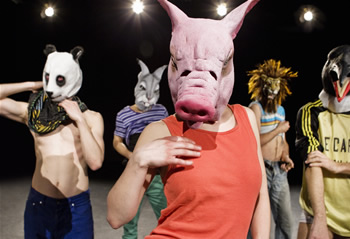It is the hope of every creative artist that their work will transcend the times that they live and continue to be relevant in an unknown future. The story of Don Juan, Don Giovanni, or whatever cultural label you wish to put on it, is a timeless tale of betrayal, murder, sex, earthly pleasures vs. everlasting condemnation — did I mention sex? Mozart’s opera Don Giovanni, with libretto by Lorenzo Da Ponte, is as timely today as it was in 18th century Vienna, or will be 200 years from now.
The Opera Company of North Carolina (OCNC), as part of their 10th season celebration, presented a modern-day adaptation of this masterpiece along with the promise of multimedia effects, spontaneous visual art creation, and many surprises. There were indeed many aspects of this production that may have been contemporary, but all that became secondary and almost superfluous to the high musical level of singers and musicians, plus of course Mozart‘s genius. The most obvious “new” feature of this production was the venue, the Meymandi Concert Hall, which was designed, engineered and built as the home for the North Carolina Symphony. This is the first time that a theatrical presentation was staged there and, at least from the audience’s perspective, it all seemed to work just fine; except for some minor anachronisms, like the absence of a stage curtain.
As one entered the auditorium, the stage was brightly lit while artist Matt Sesow was putting finishing touches on a large canvas that served as the central visual scenery. Without resorting to an art review, his work resembled Guernica-like faces that could represent the hidden cruelty of man or the horrors to be endured in a hellish afterlife.
There seemed to be an almost voyeuristic aura to the production since there was no hiding – stage entrances, scenery changes were all out in the open. The one very big exception was the outstanding orchestra – they played on stage but behind a graffiti-laden screen and, regrettably, not one musician was ever seen. This freelance group was made up of familiar names to triangle audiences led by Michael Recchiuti, Artistic Director of the American Opera Theater.
The multi-media facet of the opera consisted of two handheld cameras on either side of the stage that projected close-up images of the action on two triangular screens suspended high above the stage. This, along with the English supratitles displayed in the stratosphere of the hall, gave you plenty to look at and absorb. There was also a TV monitor that projected another image, although this was not much use to those seated in upper balconies.
One of the fears of those who spend lots of money for tickets, line up babysitters, and endure traffic and parking problems is that the lead is replaced at the last minute and they are “stuck” with the understudy. In this performance, the lead lothario, Don Giovanni, took ill and Craig Hart was the replacement. However, this was no no-name, star-is-born rookie waiting for his big chance, but a seasoned, highly respected operatic pro. He had just the right swagger, arrogance and braggadocio to portray the 18th century Wilt Chamberlain. Hart had a big, booming voice and a confident stage presence that made the audience want to hiss at his loathsome character. Timothy Nolen as Leporello, the servant of Don Giovanni, ably served as the comic foil, although the range and projection of his voice wavered throughout the evening. Kelly Cae Hogan as Donna Anna, and Christine Weidinger as Donna Elvira, held the audience spellbound during their big arias. Yungbae Yang as Masetto and Joel Andrew Weiss as Don Ottavio, had appealing but rather timid voices and lacked the theatrical élan to bring their characters to life.
I felt a bit cheated by the climactic scene where Don Giovanni gets his due rewards and painfully descends into hell via the born-again statute of Il Commendatore. There were warnings on the doors as you entered Meymandi Hall from the outside plaza about strobe lights, loud explosions and special effects. There was little, if anything to be warned about. Artificial smoke and a descending pit, plus hand-held flashlights hardly necessitate a legal disclaimer. With the money they saved on costuming, which basically consisted of people dressed like they were going to dinner at Parizade, more imaginative use could have been put to the much-advertised special effects.
This production’s success rested with what is Don Giovanni’s essence – a timeless, universal story and great music. The orchestra suffered from the offensive lineman syndrome; you don’t notice anything unless they screw up. Their effortless and brilliant playing slipped into the background even more because of their hidden, formless setup.
There were a few subtle jokes that tied in with the modern setting, like Don Giovanni’s lists of sexual conquests contained on a laptop computer and even simulated cocaine use during a party scene. However, while certainly not harming the production, the contemporary angle added little, if anything, to what is already perfect.











